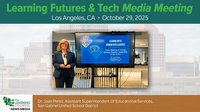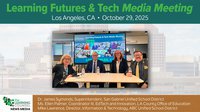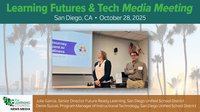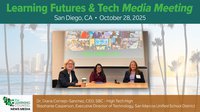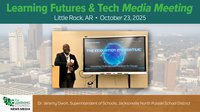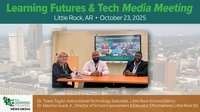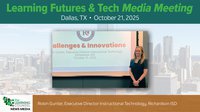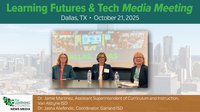The evolution of the education sector has been marked by significant transformations over the years.
Historically, education was often limited to traditional classroom settings and face-to-face interactions. For much of the 20th century, the education sector has relied on a standardized system to meet the demands of an industrialized society.
In the latter half of the 20th century and into the 21st century, the digital revolution brought about a paradigm shift in education.
The integration of technology into learning environments has given rise to online education, e-learning platforms, and digital resources, all of which have enabled greater accessibility and flexibility.
Now, (and largely due to Covid) virtual classrooms are a viable option for delivering education and there is widespread recognition of the benefits of personalized learning approaches – both have further revolutionized the education landscape, providing learners with diverse avenues for acquiring knowledge and skills beyond traditional boundaries.
This ongoing evolution reflects a dynamic response to societal changes, technological advancements, and a growing emphasis on lifelong learning in the modern era.
As we look towards what the rest of the century and beyond may hold, the sector must recognize the profound impact AI is set to have on the learning landscape - revolutionizing both educational methodologies and experiences.
The biggest shake-up of our time
The introduction of Artificial Intelligence (AI) is the biggest shake-up the education and learning sector has seen in a century. As leaders in learning and assessment technology, we view AI as an agent of positive change. Its application is transforming the education landscape and redefining learning and teaching methodologies.
AI technology is no longer a distant concept; it's here and publicly accessible – the cat is well and truly out of the bag – and steadily transforming industries across the world with breakthrough innovations in machine learning. They have the potential to change how we plan, think, and act across all industries, and the education sector is no exception —from product owners and publishers to teachers and learners.
This raises questions about responsible use and the balance between short-term benefits and long-term implications. As an emerging field, AI will continue to evolve rapidly, necessitating our commitment to adapt and explore the opportunities that come with these changes.
The most recent diffusion of AI may become a springboard for rapid transformative innovation, set to make education more personalized, immersive, and satisfying for learners and equally hassle-free for instructors or educators.
From chalkboards to machine learning - The evolution of technology in education

Despite multiple waves of technological innovation, classrooms have remained largely unchanged over the past 100 years (we founded Learnosity precisely because the existing standard of educational technology wasn't good enough).
Education has traditionally seen a very gradual adoption of new technologies, with ‘chalk and talk’ being the primary method of delivery. Now, however, education is experiencing a breakout period of rapid adoption, which distinguishes this period of evolution from those before it.
The explosion of interest and extensive incorporation of AI into various fields of operation is a testament to the rapid evolution of this technology. While AI has been with us for some time (most people are familiar with voice assistants like “Siri” and “Echo”) the notion of AI has long been lodged in our collective consciousness almost as a sci-fi concept.
The fact that AI has transformed from an intriguing concept to a tangible technology disrupting our everyday lives is truly remarkable.
A new educational paradigm for students
The traditional parameters of teaching and evaluation are undergoing ground-breaking metamorphoses. New doors are being opened to personalized learning, adaptive systems, and real-time feedback.
We are seeing a systemic shift from standardized tests to more customized assessments that more precisely reflect a student's understanding and growth.
For learners, this means the creation of personalized learning environments that assess and adapt to each student’s needs and helps individuals learn at their optimal pace – all the while, gathering key data on knowledge levels, responsiveness, areas of strengths and weakness, and adapting lessons and assessments accordingly.
These advanced algorithms can predict areas where a given student may experience difficulties and adapt to deliver the best learning outcome for that individual, signalling a whole new level of accessibility.
Digital technology serves as a vital bridge between learners and content. As it continuously evolves, it enriches the presentation and interaction of educational content to cater to a wide range of learners. The shift has enabled personalized learning experiences, allowing learners to develop knowledge at their own pace. From audio-visual aids to interactive games, digital platforms enhance engagement, making learning comprehensive and enjoyable. For learners with special educational needs, digital platforms have a pivotal role to play in providing tailored educational resources and creating equal learning opportunities.
We’re already seeing real-world applications of this kind of AI technology, such as Natural Language Processing (NLP), a branch of machine learning that gives computers the ability to process language (text and spoken word) like humans.
A new way forward for teachers
Within the K-12 sector, it's not only students that stand to gain from the implementation of AI. It is already dramatically increasing educators' productivity too. Much of teachers’ time is taken up with time-intensive tasks such as manual grading and test creation.
Not only supporting them with more efficient ways of working, AI can address the very real challenge of unsustainable workloads of teachers which has led to educators feeling burnt out and wanting to exit the profession – resulting in a teacher shortage worldwide. In the US alone, teacher vacancies were up 51% in the last year, with 44% of K-12 educators citing they always or very often feel burned out at work. We saw this when we demoed Author Aide, Learnosity’s AI-assisted test creation tool, with feedback from former teachers claiming they would have likely stayed in the profession had this technology been available to them.
The ability to automate routine tasks can free up time for more personalized student engagement and nurturing soft skills like critical thinking and creativity, which will continue to be vital for the workplace of the future.
AI can also provide educators with unique insights into student learning patterns to enable earlier intervention and allow for swift adjustment of teaching strategies for better student outcomes. This is particularly prevalent for remote learning where one-to-one contact with students may be limited.
Aside from the benefits of efficacy and better learning outcomes for students, AI represents an opportunity to revitalize learning and professional development for teachers themselves.
AI-driven professional development courses, data analysis on effective teaching strategies, and access to global teaching trends can help teachers upskill and stay updated with the changing education landscape.
Of course, as with any technology, results are only as good as the implementation. However, if strategically integrated, AI can extensively enhance an educator's productivity by minimizing administrative tasks, personalizing learning, improving student performance prediction, and enabling professional development.
Content-creating superpowers
Traditional assessment methods, such as written exams, have long served as a primary method of determining a student's understanding and knowledge of a subject matter.
While they have demonstrated efficiency in certain contexts, they also pose several challenges such as a lack of individualization. Not every student learns in the same way, and this tech can better support for easier customization while adding richer options for interactivity.
Many models focus on and promote factual recall rather than critical thinking or problem-solving skills, which are vital for a modern, dynamic world. Assessments under this system have been criticized for promoting a ‘teaching to the test’ culture, leading to the neglect of creativity, innovation, and non-academic skills. Until now, standardized testing has been the default, often due to a lack of resources to create more individualized ways to assess. With AI, we are entering a realm of more student-centric learning. These traditional models often fail to adequately prepare students for the future workplace, as they do not prioritize adaptability and digital literacy. These are among the many challenges driving educators to explore more innovative models of teaching and learning.
The education sector has notoriously been resistant to change; however, it is clear that AI cannot be ignored and should be embraced as part of a mould-breaking evolutionary pathway.
As with any new technology, questions have been raised about how it is implemented within assessment, notably regarding plagiarism, misinformation, misuse, biases, and copyright issues.
While these concerns are valid, there has always been resistance in the face of major change, and these should not deter educators from embracing emerging technologies and the benefits they bring.
There is a great opportunity for AI-assisted authoring to make test development more efficient, productive, secure, and supportive for content authors. Learnosity’s Author Aide tool is one such example of how efficiencies in test creation are helping to save huge amounts of time and improve the quality of test questions.
Author Aide is dramatically changing test creation, acting as a huge productivity booster for test creators - we’re talking about a 10x increase in author output while maintaining consistent content quality. Powered by GPT-4, Author Aide allows users to incorporate their learning material as training data so that content can be aligned with specific curricula, syllabuses, or standards.
The software allows test authors to build large banks of questions that can instantly be organized by topic and used within various assessment formats. Increasing the size of item banks in assessments helps to improve security by making it much harder to steal content and pass it to other test takers. Author Aide also helps to deliver better, more timely learner feedback and increase engagement.
This ability to raise standards in quality and significantly reduce the workload and manual intervention required from individuals is just the start for the education space.
This is a unique opportunity to improve assessment quality and learning outcomes, and we’re excited to raise the bar. Generative AI gives authors content-creating superpowers that impact how assessments are created.
By leveraging generative AI in this way, we’re helping authors increase their output – transforming a task that could take hours into something that can now be achieved in a few minutes. By integrating AI into our assessment technology, we can deliver greater value to educators, test creators, and learners.
This will be particularly valuable for small organizations that can’t afford large authoring teams or corporate L&D programs where subject-matter experts (SMEs) and content creators are separate people, with SMEs usually being massively time-poor.
Too often, an organization’s ability to deliver truly impactful, tailored, and inclusive learning is held back by a lack of resources, time, and budget. Our ambition is to go beyond the short-term application of AI to lean into the big-picture opportunity AI presents to continuously advance education and learning across the globe.
Historically, we’ve seen how innovation has been met with hostility. Oral cultures were initially sceptical of writing, believing it would weaken their memory, and the introduction of calculators caused a furore when they were brought into schools because people feared they’d lose the ability to perform mental arithmetic – and the list goes on.
As with any emerging technology, it can be a double-edged sword. Often opening doors to new challenges but can also be the key to solving some of those challenges too. It’s important to understand that the conversation around AI should not be binary, it is not all good or bad and should be approached holistically.
Regulation is a key part of a holistic view and serves as a guardrail to protect against potentially harmful outcomes such as security and privacy issues, algorithmic biases, and a potential increase in screen time for students.
A transformative leap
The advent of generative AI represents a transformative leap in the education landscape.
AI is not meant to replace human agency in the educational sphere but rather to support, enhance, and elevate it, making quality education accessible, adaptable, and equitable for all.
Its disruptive nature encourages a fundamental shift in traditional educational paradigms, opening doors to more personalized, efficient, and effective teaching and learning avenues. AI has the potential to serve as an indispensable tool for educators and learners by augmenting the teaching process, reducing administrative burdens, and delivering an intuitive learning experience.
From automating grading systems to providing real-time feedback, AI is reinvigorating how educators teach and students learn. AI-based assessment tools enable a more accurate and thorough evaluation of student performance, highlighting areas of weakness and strength in real time.
While the full potential of AI in education has yet to be realized, the technology holds enormous promise. The rapid pace of AI adoption and innovation reflects our society's eagerness to tap into its myriad benefits and optimize learning and teaching methodologies.
About the author

Gavin Cooney is the CEO & Co-Founder of Learnosity. He is passionate about driving improvements in the field of learning and assessment by making a higher standard of technology available to users globally.



